Having the Factory Light Itself
投稿人:Convergence Promotions LLC
2012-04-18
The industrial lighting application space is segmented between in-office and in-factory applications. In-factory applications require long lifetimes for components, minimal servicing, and autonomous operation. These features make the factory floor and its associated lighting solutions prime candidates for support from local harvested energy solutions with extended product replacement/repair lifetimes.
The use of solar and piezoelectric sources to help support localized lighting is gaining popularity as lighting power drops down to levels made possible by new high-efficiency harvesters. The key to implementing these systems is the storage and distribution of the power that is collected. Selection of the correct type of lighting, the driver option, and the power storage and regulation environment are the main elements in the successful deployment of these self-powered systems.
Types of lighting
Industrial lighting in factories has long been characterized by high-power, high-wattage area lighting. In addition to fluorescent tube lighting and large-format circular lighting, factories have also used halogen and sodium bulbs. These are in addition to the traditional incandescent lights, available in spot, flood, and regular bulb format. The sodium bulbs are all controlled by 110 to 240 volt AC supplies which drive the ballasts and the lights with high current levels. Most of these lights have supplies in the 70 to 500 watt range and generate a great deal of heat in addition to light. They have good efficiency for their class in the 100 to 200 lumens per watt range with a moderate life of 10,000 to 20,000 hours.
Halogen bulbs use a newer material mix than in traditional incandescent bulbs. These bulbs typically have a 2,000 to 10,000 hour life. The challenge has been in the power needed. Halogen bulbs, like sodium bulbs, are 110 to 240 volt AC devices that run in the 50 to 1,000 watt range. For both of these alternatives, harvested power is not very practical other than large scale alternative energy solutions (wind, geothermal, and high-power solar).
The lighting solutions that can run from harvested energy are standard and high brightness LEDs (HBLEDs). These lighting products operate from 1.8 to 10 volts DC and typically provide operating solutions in the sub-10 watt range. Standard LEDs such as the Lite-On LTST-C191KRKT Red LED (Figure 1) support power efficiency in the 60 to 100 lumens per watt range. Similarly, HBLEDs, such as the Cree CLA1B-MKW White HBLED (Figure2) have power efficiency in the 175 to 200 lumens per watt range. These devices operate in the sub-10 volt (typically 3.3 to 5 volts) range with forward bias current in the milliampere range. Both the standard LEDs and HBLEDs have an application life near 100,000 hours, which makes them ideal for difficult to access industrial lighting.
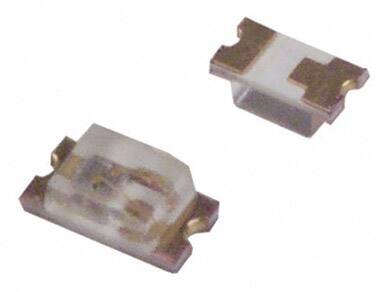
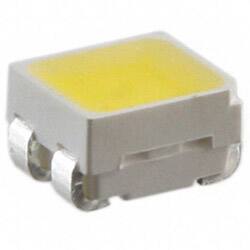
Whereas standard lighting types are available in white shades (cool, soft, and warm), LED lights are available in very specific wavelengths and colors in addition to white. Standard LEDs are lower power and are available from many manufacturers such as Cree, Inc., Panasonic, Lite-On, Vishay, Fairchild Semiconductor, and others. These are available in amber, blue, green, yellow, red, and shades of white. HBLEDs are also available from numerous manufacturers –including Cree, Lumex, Sharp Microelectronics, Toshiba America Electronic Components, OSRAM Opto Semiconductors, and ROHM Semiconductor – and are available in colors and optimized white to allow for replacement of high voltage lighting.
One challenge with solid-state lighting that is different from high voltage lighting is the effect of temperature. Since the light produced by LEDs is the result of an electronic process (diode), there is a temperature effect based on the change in the drive current. Figure 3 shows a typical temperature operation curve for a HBLED device (Cree XLamp® series) over the zero to 100°C junction temperature range inside the package of the device. These devices improve in performance at low temperatures. The environment must be temperature aware, since the stability of the regulators and their associated passives also have a temperature dependence that must be factored into the design.
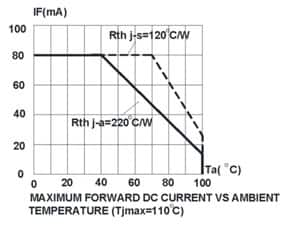
Energy collection components
For the industrial application space, there are two energy harvesting technologies that are applicable. One is solar and the other is a piezoelectric collector that can capture the energy from motion. Previously the solar option was not practical for in-site applications. However, with the reduction in operating voltage and current needed for the lighting solutions, smaller solar cells – some with efficiencies up to 22 percent – can now be used. New solar cells such as IXYS Corporation’s KXOB2201X8 IXOLAR™ solar cell (Figure 4) are small-footprint cells (22 mm x 7 mm x 1.8 mm) that produce 3.4 volts at 3.8 mA even in low light. These cells can be connected in series or parallel to create the appropriate voltage or current needed to run the lighting, regulator, or sensor. Solar cells are available in multiple sizes, each producing a different voltage and current. These cells can be connected together to generate a wide range of voltages and currents. For use in an industrial application, the power generated is stored for later use when solar energy is no longer available, such as in the evening.
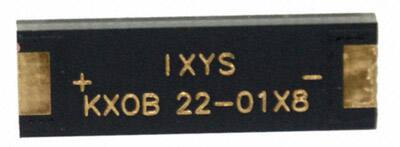
On the motion collection side, the dominant technology is a piezoelectric energy harvester. Midé Technology’s Volture™ series (Figure 5) has a number of different PZT paddles that produce varying amounts of power based on movements. These harvesters (Midé Technology V25W-ND) create energy from either the x- or y-axis displacement of the end of the PZT material. The output of the harvester can be connected in series or parallel to provide the correct voltage and current that is needed for the regulator, lighting application, or sensor that is connected to the source. Similar to solar collectors, these harvesters primarily store their energy in a repository for use by the applications when needed. This energy storage mechanism reduces the dependence on trying to balance the active current draw/voltage draw with that of the energy harvesting system.
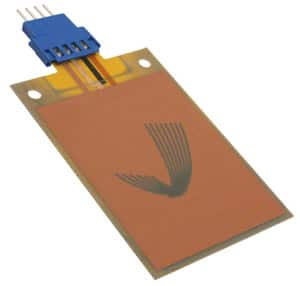
Energy storage options
Since the collection time for the energy harvesters does not necessarily coincide with the power demand by sensors and lighting, the energy has to be stored in an easily retrievable form. The three most common components are rechargeable batteries (multiple material choices), supercapacitors, and new solid-state energy storage chips.
Batteries are the best known technology. They have the advantages of being low cost, easily available, having standard connectors, and being the available in many different voltages and storage capacities. Batteries have a moderately long useful lifetime, often close to five years. The challenge with batteries is temperature and environmental support. Batteries are physically large and heavy, and as a result require mechanical planning to be used in a system.
Batteries are a DC system that has a decaying voltage at a fixed current draw, which results in an impedance change looking into the terminals over the use life of the battery. This eliminates the need for a rectifier on the regulator in order to drive the sensor and lighting systems.
Supercapacitors, such as Taiyo Yuden’s PAS414HR-VA5R (Figure 6), are another storage method. They are a cross between a battery and a capacitor. Their distinguishing characteristic is a smaller size for a given voltage level compared to a battery, while providing a similar level or current. Their drawback is the total power stored is smaller than that in a comparably sized battery. Additionally, supercapacitors have different electrical characteristics and require a different regulator and charging circuit from a battery. Supercapacitors can provide up to ten years of operation before requiring a change. This is a significant improvement over the servicing cycle for a battery.
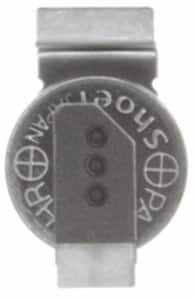
The last option is relatively new – a thin-film storage device, similar to a battery, is a solid-state, surface-mountable component. Cymbet has a product line called the EnerChip™, a solder reflow tolerant solid state component. The surface-mount package (used in the EnerChip CBC012 in Figure 7) can produce 12 μAh at 3.8 volts with a ten minute recharge to 80 percent capacity; the Enerchip device supports over 5,000 recharge cycles. These devices can also be connected in series or parallel to create the power levels needed to drive regulators, lighting sources, and sensors. The primary use for these devices is providing standby power for SRAM and microcontrollers.
Power regulation
Power regulation is critical for LED lighting. Being able to collect energy from energy harvesters and store it is one aspect of the power regulation story. Specialized controllers such as Linear Technology’s LTC3225 supercapacitor charger can be used to drive the power to a supercapacitor for storage. Similarly, there are battery-charge regulators from Texas Instruments and National Semiconductor. The multi-part regulation system has to include regulators and converters like the National Semiconductors’ SM72442 power tracking controller and Linear Technology’s LTC3588 high-efficiency buck converter for use with PZT energy harvesters.
These regulators then drive traditional constant-current LED regulators such as CUI, Inc.’s VLD24-300. This is a programmable-voltage, fixed-current output device designed to have a switch control to drive both LEDs and HBLEDs. Some of these regulators and drivers include all of the PWM control logic and drivers in addition to boost and/or buck converters. Products like the Linear Technologies LTM8042 include the boost LED drivers and support multiple devices and drive channels. While it is designed for LED dimming for flat panel displays, the control mechanism and the device design for the LED backlight is the same as for modern distributed LED panels used for machine-specific area lighting in factories.
Support components
One of the challenges in the industrial use of these regulators to drive LED lighting is the wide industrial temperature range. These regulators use resistors, capacitors, and inductors that all change their characteristics over a large operating temperature range. As a result, in order to address the typical -20°C to +100°C operating range, you see a large variation on the value of these components, even if they were high precision for nominal 27°C operation.
It is not unreasonable for small-value resistors to shift by more than 100 percent of their baseline values over this temperature range. As a result, the amount of power that is available from the regulators may change dramatically. To insure correct operation of the resulting lighting circuits, these temperature effects must be taken into account when creating the regulator using component materials and assembly methods that help minimize the problem.
The use of multiple regulators in a design, coupled with the need to control and recharge storage devices, increases the amount of power that must be harvested in order to operate lighting and sensor solutions. The lighting solution itself is highly efficient; however there are losses in the total power supply path for the system. A typical design would have an energy harvesting device, a primary controller, a converter, a regulator to drive and recharge the storage devices, the storage device itself, an output regulator, an LED driver, and the lights themselves. This whole system may require an energy harvesting solution on the order of two to five times the size of what would be required just to supply power to the LED lighting. The cost and complexity are easily justified, since the result is typically five to ten years of maintenance-free operation.
Summary
The industrial control marketplace has a number of unique lighting applications that can benefit from energy harvesting solutions. These solutions result in extended serviceability and reduced operating cost, important goals in a factory automation environment. Many new low-voltage/low-current lighting control systems are being put into place now. Assisted by energy harvesting systems, these solutions will only continue to expand to new applications and markets.

免责声明:各个作者和/或论坛参与者在本网站发表的观点、看法和意见不代表 DigiKey 的观点、看法和意见,也不代表 DigiKey 官方政策。






 中国
中国